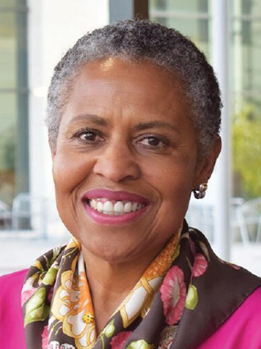When Jewel Mullen, M.D., MPH, arrived at the University of Texas Dell Medical School in Austin as associate dean for health equity in 2018, she says it was the students who demanded health equity training.

“The medical students came to me in my first month and said, ‘we want required curriculum on social determinants of health and race. And we have been unable to get that buy-in from our medical education people. Can you help us with that?’”
Later, a student-led survey found that two-thirds of graduate medical students felt “brushed aside” if they prompted discussion around social determinants of health or racial disparities with their classmates or faculty members.
The students’ demands marked a critical beginning milestone in developing the Health Equity Strategic Map that Dr. Mullen spearheaded at Dell Medical School. Before Dell Medical School, Dr. Mullen served as principal deputy assistant secretary for health at the U.S. Department of Health and Human Services and commissioner of the Connecticut Department of Public Health.
Dr. Mullen focused on bioethics in her residency at the Hospital of the University of Pennsylvania, developing her commitment to justice in health early in her career. “Equity is really an ethical principle.”
As medical education evolves to meet today’s health care demands, medical school leaders in Texas are contending with the challenge of prioritizing health equity in graduate medical training and residency programs. Texas boasts a diverse population and growing health care demands, both of which require a knowledgeable and equipped physician workforce that can address the role of inequities in health outcomes. Texas Hospitals Magazine spoke to medical education leaders who are exploring and implementing innovative health equity training into the classroom and clinic and supporting a diverse medical student body that will meet the state’s health care needs.
Health Equity > Achieved when every person has the opportunity to reach their full health potential without being disadvantaged by their socially determined circumstances or social position. Centers for Disease Control and Prevention.
Health Disparities > A particular type of health difference (injury, disease, and opportunity for optimal health) that is closely linked with economic, social or environmental disadvantage. Centers for Disease Control and Prevention Healthy People 2020.
Social Determinants of health > The conditions in which people are born, live, earn, work, play, worship and age, affecting health, functioning and quality-of-life outcomes.
World Health Organization
Health equity matters in medical education. Evidence shows that clinician bias can result in lower patient satisfaction, higher levels of mistrust, a lack of follow-up and adherence among patients, as well as racial disparities in pain medication prescription. According to a 2016 study in the Proceedings of the National Academy of Sciences of the United States of America, half of white medical students and residents surveyed held false beliefs around biological differences between Black and white people—like the myth that Black people have thicker skin and higher pain tolerance compared to white people.
A 2021 Journal of the American Medical Association (JAMA) study analyzed all-cause mortality rates and Black-white inequities from the 30 most populous U.S. cities found the Black all-cause mortality rate was 24% higher than among white populations nationally, resulting in 74,402 excess Black deaths each year. The study’s city-specific findings found the Black mortality rate was 44% higher in Houston, 20% higher in San Antonio, 33% higher in Fort Worth, 48% higher in Dallas, and 40% higher in Texas. El Paso was the only analyzed Texas city that did not have a significant Black-white mortality inequity.
Not only do the health disparities cost lives, but they also tax the national and Texas budget. Data show that racial and ethnic health disparities cost Texas families, employers, insurers and the government an estimated $2.7 billion in excess medical spending and another $5 billion in lost productivity, according to a 2020 Episcopal Health Foundation report.

“Our entire country is faced with the challenge of improving the value of their health care. We spend more money on health care than any other country on earth, and you might think we have the best health, but that’s not the case,” said Stephen Spann, M.D., MBA, inaugural dean at the University of Houston College of Medicine.
A family medicine and global health education leader, Dr. Spann has devoted his career to training future health care professionals and treating patients from underserved populations in rural settings and abroad.
His professional background, which helped him “understand our health care system and the needs within our health care system,” aligns with the school’s mission, which includes addressing one of Texas’s pressing health care needs— a shortage of primary care physicians.
Dr. Spann said that Texas needs over 5,000 additional primary care doctors to reach the national rate of primary care doctors per population.
In fact, Texas needs approximately 5,065 primary care physicians (M.D. trained) to reach the national rate of primary care physicians for the population, according to the 2019 State Physician Workforce Data Report. Texas ranks 47th for active primary care physicians at a rate of 66 per 100,000 residents, compared to the national rate of 83.6.

Diverse Student Body
Racially, ethnically, culturally diverse and inclusive health care organizations are critical for promoting equitable health care in the U.S., especially in a state as diverse as Texas. Recruiting and supporting medical students from underrepresented backgrounds is key. According to 2016 data from the Texas Higher Education Coordinating Board, 4.6% of medical students were Black, 16.5% were Latino, 27.3% were Asian and 44% were non-Hispanic white.

“It has also been widely documented that African American, Hispanic and Native American physicians are much more likely than white physicians to practice in medically underserved areas,” said Chiquita Collins, Ph.D., the inaugural vice dean for inclusion and diversity and chief diversity officer at the Long School of Medicine at The University of Texas Health Science Center at San Antonio (also referred to as UT Health San Antonio).
UT Health San Antonio was recently ranked the 16th best medical school for diversity by U.S. News & World Report’s Best Graduate Schools and has a collection of programs dedicated towards K-12 pipeline recruitment programs, mentorship and prioritizing minority-serving institutions for recruitment. In 2019, UT Health San Antonio partnered with the Centers for Applied Science and Technology Medicine High School, a charter public high school in San Antonio with health and research tracks that uses a lottery system of admission to prevent bias against students from socially disadvantaged backgrounds and garner interests and support for such students to enter health care professions, Collins wrote in an email response.
“More and more medical schools are paying attention to these holistic packages. We don’t have any evidence that your GPA or standardized test scores are predictors at being a great physician.”
STEPHEN SPANN, M.D., MBA, DEAN AT UNIVERSITY OF HOUSTON COLLEGE OF MEDICINE
At the University of Houston College of Medicine, 73% of the student body identify as an underrepresented minority in medicine. Spann says their admissions process does not focus on race and ethnicity. Instead, “We have a very deliberate focus on young people whose backgrounds and characteristics are predictive of primary care specialty choice.” Whether applicants’ parents were in serving positions, experiences between college and medical school, community-based volunteering, are among the “evidence of resilience and grit” considered. Although there is a GPA and MCAT score minimum to be evaluated for interviews, they are not considered once an interview is granted.
“More and more medical schools are paying attention to these holistic packages. We don’t have any evidence that your GPA or standardized test scores are predictors at being a great physician,” said Dr. Spann.

Dell Medical School also uses holistic admissions methods. “We look at experiences and what you might bring to enrich the greater Dell community,” Beth Nelson, M.D., associate dean of undergraduate medical education at Dell Medical School’s Department of Medical Education. Dr. Nelson has been a leader in medical education curriculum reform around patient safety and quality improvement. Additionally, she provided care for uninsured and under-resourced patients in the Harris Health System. She led the team at Dell Medical School that created the health equity integrated medical education, resulting in Dell Medical School’s four health equity competencies: historical context, personal and interpersonal, community awareness and society, and intentional disruptive action.
Dr. Nelson says that one of their goals is to train Texas physicians to think about and address injustice in medicine with deliberate action: “What are some big issues within our community that I’m seeing over and over impacting health care? And how might I think about how as an individual or as the community of Dell advocate for change in that space?”
Health Equity Curriculum and Training
Medical students may be comfortable discussing health equity and driving for a change in curriculum and climate, but integrating health equity into curriculum and training requires buy-in from the entire educational community, said Dr. Mullen.
One of the first steps Dr. Mullen took to create Dell’s health equity strategic plan was to conduct a “physical,” assessing the school’s strengths and weakness around health equity by holding “think tanks” to discuss elevating health equity in the college: “Everybody, students, faculty, staff, including cafeteria, facilities, security, all are welcome to come and have conversations about ‘What does health equity mean to you? What’s happening in your work? What do you want to see?’”
Building internal and external support for prioritizing health equity in medical education meant interdisciplinary dialogue and collaboration, or “cross-talk,” as Dr. Nelson mentioned, which partly addresses “the biggest challenge is the lack of understanding of concepts around health equity.”
Some medical departments, like psychiatry, may be more familiar with health equity concepts, Dr. Nelson said, so having cross-talk dialogue can help foster knowledge and communication about health equity in medicine.
Dr. Nelson says they are planning opportunities for hospital leadership to speak with medical students, so providers are equipped to communicate the systemic issues they observe in patients with those who can make necessary programmatic and policy changes. “You don’t find all the solutions and approaches to health equity only in a medical school,” said Dr. Mullen.
Interviewed leaders’ schools reported utilizing didactic and practical methods to integrate health equity training in graduate medical education, such as training and modules around implicit bias, anti-racism, and the social determinants of health; clinical skills in disabilities care and culturally responsive care; and clerkships that emphasize culturally sensitive care.
“We have a case-based curriculum where students learn even the basic sciences through clinical cases, and most of those cases have social determinants issues woven into them, so there’s something that’s not just an add on or an afterthought it’s integral to our curriculum,” said Dr. Spann.
“Our students spend half a day each week for an entire four years of medical school in a primary care clinic.” With some of the sites being federally qualified health centers, students at the University of Houston College of Medicine are “exposed to patients and families with real-world problems.”

“We can’t create a safe, warm, humanistic environment in the preclinical experience and then throw cold water if they go to the clinical environment. And we can’t talk about what students need to learn. So we have to continue to talk about what faculty have to learn.”
JEWEL MULLEN, M.D., MPH, ASSOCIATE DEAN FOR HEALTH EQUITY AT UNIVERSITY OF TEXAS DELL MEDICAL SCHOOL
In addition, students are assigned to provide care for families from medically and socially disadvantaged communities on “a longitudinal basis to really understand those very issues, social determinants and the challenges of navigating a very fragmented health care system,” said Dr. Spann.
The school’s Household-Centered Care, in partnership with Unite Us, is a coordinated care network, in which medical providers, including students, are paired with social services workers to follow a family on a longitudinal basis, focusing on societal and structural factors that impact housing, employment and food security.
A 2021 JAMA study found evidence that a longitudinal health equity curriculum that covered education, community and organization domains, and was combined with clinical clerkships and partnered with community-based organizations was associated with an improvement in students’ self-reported understanding of the social determinants of health.
Dr. Mullen emphasizes faculty education in health equity as well. “We can’t create a safe, warm, humanistic environment in the preclinical experience and then throw cold water if they go to the clinical environment,” said Dr. Mullen, “And we can’t talk about what students need to learn. So we have to continue to talk about what faculty have to learn.”
Interviewed leaders spoke about contending with how they will assess health equity mastery among their medical students. “Those assessments don’t really exist in the equity space, so we’re having to think through how do you show competence in some of these areas that we haven’t historically tested students on,” said Dr. Nelson.
Dr. Spann says that specialty choice, diversity of student body and the health status of the surrounding community they serve are other markers to measure health equity training.
He says the long-term goal of seeing an elevation in health in the Third Ward – the historically Black neighborhood in Houston – where almost one-third of residents do not have any health insurance, a rate higher than the county average, and nearly one-in-five residents rate their health as “fair” or “poor,” according to 2017-2018 data analyzed by the Baker Institute for Public Policy at Rice University.
When it comes to prioritizing health equity in graduate medical education, it is a long-haul project that takes the work and cooperation of students, staff and faculty. “[T]his, this is not easy. Like this is not next year, come back. And it’s all done,” said Dr. Mullen.
